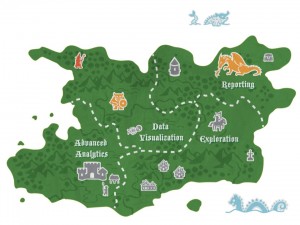
In my quest to address the opportunity of big data for marketers, I've had a chance to collaborate recently with Tamara Dull, a colleague who's an expert in this field and who is also super-creative. Perfect for marketing, right?
Well, she developed a concept she calls "The Big Data Archipelago," which provides us with the opportunity to approach big data in a way that may fit more easily into any of our operating realities - and in my opinion, that's precisely what makes it compelling. It's practical.
You may be familiar with the 3 V's of Big Data - originated by Gartner Group as part of a framework for defining and therefore understanding the challenge of big data. The 3V's are very useful as a starting point, but once you get the concept, how do you apply it to your own organization? An approach like The Big Data Archipelago breaks it down into bite-sized chunks that can help you frame the challenge more easily in the context of your operating environment, and therefore help you understand the opportunity in practical, realistic terms that matter to your organization. Here is the overview:
The Big Data Archipelago has 10 "islands," and each island addresses a different aspect of big data. What I find particularly interesting is how Tamara highlights the way big data has brought about changes in accepted best practices on each of the 10 islands:
Analytics
Traditional: Gain insight by answering the known unknowns.
Big Data: Make an impact by discovering the unknown unknowns.
Processing
Traditional: Try to optimize the data warehouse around mixed workloads.
Big Data: Take advantage of the processing power of big data technologies.
Integration
Traditional: Build it and they will come.
Big Data: Build it on demand, using the best tools for the job.
Open source adoption
Traditional: Compare open source solutions by functionality and price.
Big Data: Take open source seriously for big data platforms.
Location
Traditional: Centralize data and platforms.
Big Data: Allow data to reside where it will provide the greatest value.
Data governance
Traditional: Develop an enterprise-scale data governance program.
Big Data: Tackle data governance one big data project at a time.
Data security
Traditional: Hold IT responsible for data protection.
Big Data: Foster a culture where data is treated as a corporate asset.
People
Traditional: Evolve toward a competency center.
Big Data: Focus on individual roles and skills.
Investment
Traditional: Calculate ROI focusing on software acquisition, licensing and maintenance.
Big Data: Calculate ROI focusing on new development processes, organizations and skills.
Strategy
Traditional: Use data to help achieve corporate strategic goals.
Big Data: Use data to help achieve community and global goals.
In addition to helping translate big data into practical terms, the Big Data Archipelago relates the 10 islands in ways that explain why it's an archipelago and not a random set of 10 different islands. It's worth exploring in the order above and by time you get to island #10 (Strategy), it should be apparent how this approach can be a catalyst to delivering strategic value to your organization.
Tamara detailed the Big Data Archipelago in a series of posts on our sister blog, The Customer Intelligence Knowledge Exchange. A marketer's journey through the big data archipelago is the first post in the series, which provides a nice overview and links to the posts on each of the 10 islands.
It's an eye-opening journey that's worth taking. Please send postcards from your journey in the form of comments.
